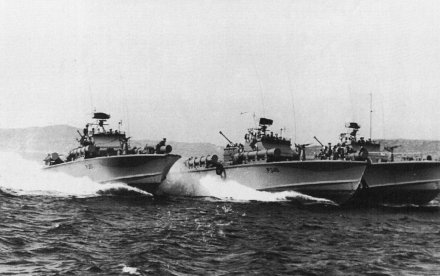Pre-Vietnam: Development of the PTF NastyHistory for the PTF began in the late 1950's when the prototype motor torpedo boat NASTY was developed for the coastal anti-invasion mission of the Royal Norwegian Navy, as a follow on to their U.S. built PTs and British Fairmile "Ds". It was a private venture financed by shipyard entrepreneur Westermoen. The NASTY was designed by Jan H. Linge in close cooperation with World War II experienced officers of the Royal Norwegian Navy. Linge used a computer to analyze the features of the best patrol boats developed up to that time and to test improved designs. The prototype was completed in Autumn of 1957 and it was successful in tests by the Royal Norwegian Navy.
Survivability features include low silhouette and low radiated signatures (magnetic/IR/acoustic). There is redundancy in the engineering plant, with manual backups for pumps and steering. Watertight compartmentalization includes features of fire and flooding control, as well as protection from nuclear, biological, and chemical contamination. The extremely wide beam (about 1/3 of the length) incorporates a "V" bottom, hard chine after part with a round bottom forward. It efficiently carries heavy loads and a large crew of 19 plus two squadron staff members. Due to her long range capability of over 1000 miles, seats are provided for the steersman and commander. During cold weather operation, heated suits are worn by those in the open bridge. The NASTYS feature British Napier (now Paxman) Deltic turbo-charged opposed piston diesel engines (18 cylinders). They have integral gear boxes which connect to "V" drives, with a ratio of 1:1, and develop 3100 S.H.P. each. These fresh water cooled engines are made mostly of aluminum, have low magnetic signatures, run cool to the touch and weigh only 13,000 pounds. They were developed based on fast patrol boat experiences of World War II. First fit in the Royal Navy DARK class in 1953, these engines have since served in 18 navies, and have operated from the arctic to the tropics. Most engine exhaust is directed underneath the hull to muffle noise, minimize infrared (IR) signature, and reduce water resistance. Royal Norwegian Naval experience with the engines has been excellent, with overhauls scheduled after normal operations of 1,500 hours a year. The engines can be lifted out and replaced easily to minimize boat downtime. Selected for VietnamIn all, 42 NASTYS were built in Norway: 20 for their own Navy's use, six for Greece, two for Turkey (as war reparations from West Germany), and 14 were built for the US. Designated PTF, these 14 were bought for use in Vietnam. Six more PTF's were built in the U.S. by John Trumpy and Sons of Annapolis, Maryland (some parts, such as the keel and stem were imported). In Vietnam they operated out of DaNang, were crewed by the South Vietnamese Navy, and carried 12 man Vietnamese Army SEAL Teams. The NASTY PTFs supplemented a large U.S. force of aluminum hulled patrol boats.
DeploymentThe US Navy trained Vietnamese crews on Norwegian Boats. These boats were active in coastal bombardment, covert maritime operations, and amphibious raids against transshipment points to destroy/disrupt normal logistic flow. They were used to intercept and destroy infiltration trawlers that had been designated a threat and destroy/disrupt the North Vietnamese fishing industry along the coast of North Vietnam. Summary of History Section Pages
|
|
|
